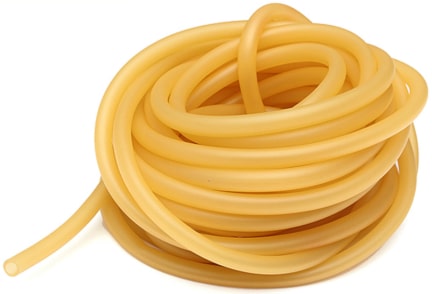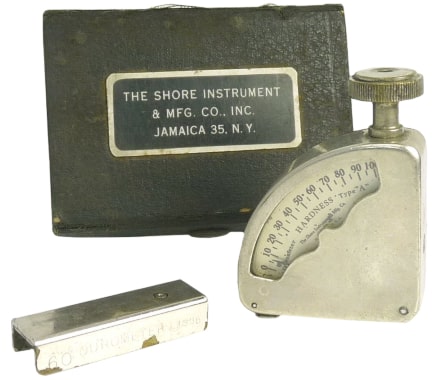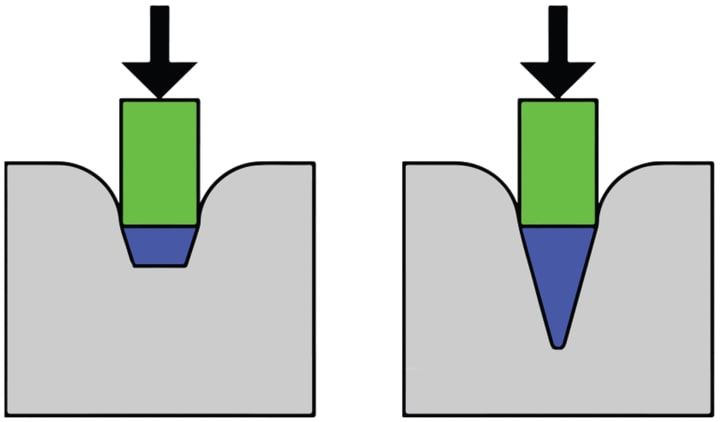What is Durometer? – Elastomer and Plastic Hardness
Durometer affects what type of materials and fittings you use for your application

Latex rubber tubing
What is durometer?
Durometer or Shore durometer is a standardized way to measure the hardness of materials like rubber (elastomers) and plastics. Durometer measurement scales range from 0 to 100 but there is no such thing as a durometer unit of measurement. Another way of saying this is that durometer is a dimensionless measurement.
Durometer numbers simply represent a relative comparison of hardness between different but similar materials that have had their hardness measured using the same durometer scale, device and measurement standard.
In general, a higher durometer elastomer is harder than a lower durometer elastomer. For example, a 90A durometer polyurethane tubing is harder than a 70A polyurethane tubing.
Shore hardness or durometer is actually a collection of internationally recognized measurement standards based on Shore durometers. Shore durometers themselves are measuring devices that use specific, standardized techniques for measuring hardness. Shore hardness standards provide a consistent, universal, easily reproducible reference that anyone can use to compare material hardness.
Figure 1 this Latex rubber tubing from ISM is 35A durometer or 35 Shore A durometer.
What are Shore A and Shore D?
For most rubber materials, Shore durometer numbers are usually provided as either Shore A or Shore D, two different but related Shore durometer scales. Shore A durometers are for softer materials and range widely enough to cover flexible rubbers all the way up to semi-rigid plastics with almost no flexibility. Shore D durometers are for harder materials and compare hard rubbers, semi-rigid plastics and hard plastics.
The ASTM D2240 standard actually recognizes twelve different Shore durometer scales for testing rubber hardness. The most common Shore durometer scales used are Shore OO, Shore A and Shore D. Shore OO measures extremely soft rubbers and gels. This is why it is much less common to see OO durometers in relation to flow control components
There is also another similar rubber hardness measurement that is called the International Rubber Hardness Degrees (IRHD) standard. There is no direct relationship between IRHD readings and Shore durometer. Shore durometers are generally preferred for referencing rubber and plastic hardness because they have been so widely adopted and are so fast and easy to measure.
Understanding the IRHD and Shore Methods used in Rubber Hardness Testing from H.W. Wallace and Company Limited, a supplier of rubber and plastic materials testing equipment. This article is an in-depth comparison of IRHD and Shore test instruments and the differences between the tests. It also describes the benefits and limitations of each standard.

A 1940s Shore Durometer
What are the origins of Shore durometer?
The Shore A hardness standard, the measurement device and how it is used were all developed by Albert Ferdinand Shore in the 1920s. The Shore durometer is actually the name of the measurement device. Over time the name of this tool and its shortened form, durometer, have become a shorthand way of referring to a material’s hardness number provided by the device.
Expert Knowledge Test Procedures of Elastomer Components from O-Ring Prüflabor Richter GmbH, an accredited testing laboratory for elastomers and seals. This article is an in-depth technical and historical review of the development of Shore A durometer testing with reference to modern equipment and techniques.
Keep in mind what the word durometer actually represents:
- A measurement tool and the testing procedure for using it
- A specialized, self-referencing scale for comparing the hardness of a comparable group of materials
Note: Hardness measurements are dimensionless. This is the main reason comparing hardness numbers between different hardness scales is not recommended. Though these sorts of charts are widely available, comparing different hardness scales are only useful as rough comparisons.
If you're enjoying what you're reading... please let us know by subscribing to our blog. You'll receive an email notification whenever we post a new article.
What actually is hardness?
Hardness or material hardness is a material's resistance to being penetrated or permanently indented. It is obviously important to have some idea of how hard a material is before choosing it for your application. This is especially true for plastics and rubbers.
For all materials testing, hardness tests measure the depth of indentation in the material created by a given force using a standardized pressure foot or indenter.

The Shore durometer hardness test
Figure 3 is a simplified graphic representation of a Shore durometer hardness test.
The arrows represent the applied load or force the Shore Durometer puts on the material. This load is acting through the indenters or instrument tips. The indenter on the left is for the Shore A test standard (822 grams spring force) and the indenter on the right is for the Shore D test standard (10 pounds spring force).
Notice that there are significant differences between the shapes of the indenter tips. Type A indenters have a 35° cone angle and Type D indenters have a 30° cone angle. Type A indenters have a “truncated” or flat tip that is 0.79 mm in diameter. Type D indenters have a sharper tip with a rounded end that is 0.1 mm in diameter.
Rex Gauge Company has a reference chart showing the applied loads and indenter shapes for the nine core Shore durometer standards.
Why does durometer matter for flexible plastic tubing?
Knowing the durometer of a flexible plastic tubing is especially important. This is because the recommended durometer tubing for a particular hose barb design provides the best blow-off and pull-off resistance. It also creates a better seal with less risk of leaking.
Barb Connectors in Depth – Design and Function >>
Check out this blog post to get some insight into hose barb design and how this might affect your application.
A selection of plastic hose barb designs
Figure 4 shows some of the most common plastic hose barb styles found on ISM plastic hose barbed fittings.
Get a copy of our Plastic Hose Barb Styles Comparison Chart >>
Heat seal silicone rubber sheets
Why does durometer matter for high temperature silicone rubber?
Durometer choice also matters when choosing the durometer of a high temperature silicone rubber for use in heat seal packaging applications. In fact, it is critical to process control. An example of this is that harder durometer United Silicone heat seal silicone rubbers provide better heat transfer properties than softer durometers.
For this reason, United Silicone high temperature silicone rubber sheets in the 70 to 90 Shore A durometer range are the recommended choice for the heated side of heat seal tooling. 60 durometer or lower is suitable for unheated applications. This is because the unheated side of your heat seal tooling won’t need the faster heat recovery you get with the higher durometer or harder rubber sheets.
Some Heat Sealing Frequently Asked Questions >>
Get more information about using United Silicone high temperature silicone rubber sheets for fabricating heat seal tooling.
What about other material hardness scales such as Rockwell?
Because material hardness is important information, there are actually quite a few different types of hardness tests and hardness scales. The two most widely recognized groups of hardness scales are Rockwell and Shore (durometer). Rockwell hardness is used to compare the hardness of metals but there are Rockwell hardness scales suitable for the harder plastics such as polycarbonate (PC), nylon (PA) and acetal (POM). Overall, there are thirty different Rockwell hardness scales because, like Shore hardness, the same testing procedure is not suitable for all types of metals.
In general, it is difficult to compare hardness scales because they use different instruments and testing methods. Generally, they can only provide rough rule-of-thumb comparisons of material hardness.
Why can’t you compare different hardness scales?
Hardness numbers are:
- Measurements made using specific testing equipment and testing methods
- Dimensionless numbers that compare material hardness only within a specific group of related materials
Each type of hardness scale uses equipment and testing procedures appropriate to that class of materials. This means that there is no simple, direct relationship between a material's hardness on one scale and what its hardness would be on any other hardness scale.
Other physical properties of materials
Another thing to keep in mind is that hardness alone is not a good predictor of a material's other properties such as strength and its resistance to scratching, abrasion or wear. For example, a rubber’s stiffness and compression modulus measurements are much more accurate than durometer for indicating the sealing performance of O-rings made from that rubber.
Even so, hardness is an important material characteristic and standardized hardness testing methods provide objective and repeatable ways to measure and compare similar materials.
Key takeaways
There are several key points to keep in mind when looking at durometer numbers.
- Each type of hardness testing uses testing procedures appropriate to that class of materials.
- Durometer is a self-referencing scale that compares the hardness of a particular group of materials: elastomers and plastics.
- There are a number of durometer or Shore durometer scales but Shore A and Shore D are by far the most useful and commonly used Shore durometers.
If you found this article useful... please consider subscribing to our blog. You'll receive an email notification whenever we post a new article.
« Go back to the blog homepage

